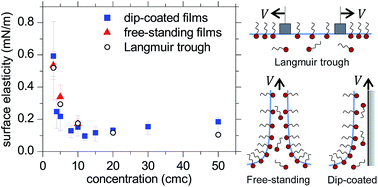Surfactant-induced rigidity of interfaces: a unified approach to free and dip-coated films
Abstract
The behavior of thin liquid films is known to be strongly affected by the presence of surfactants at the interfaces. The detailed mechanism by which the latter enhance film stability is still a matter of debate, in particular concerning the influence of surface elastic effects on the hydrodynamic boundary condition at the liquid/air interfaces. In the present work, “twin” hydrodynamic models neglecting surfactant transport to the interfaces are proposed to describe the coating of films onto a solid plate (Landau–Levich–Derjaguin configuration) as well as soap film pulling (Frankel configuration). Experimental data on the entrained film thickness in both configurations can be fitted very well using a single value of the surface elasticity, which is in good agreement with independent measurements by mean of surface expansion experiments in a Langmuir through. The analysis thus shows that soap films or dip coating experiments may be used to measure the surface elasticity of surfactant solutions in the insoluble limit, namely as long as the film generation dynamics is fast compared to the surfactant adsorption timescale.


 Please wait while we load your content...
Please wait while we load your content...